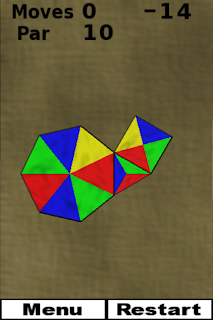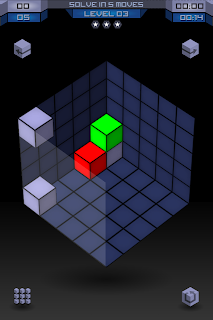It's finally time for the big list of the best puzzle games of 2013.
I don't update this blog daily, so I "only" reviewed about 60 games this year. Among them, I tried to pick just ten which I enjoyed playing the most. I had to leave some out; that's the nature of these things.
This is a very subjective list, so your mileage will vary. Let's get started.
NB: some of these games were actually released at the end of 2012, but I reviewed them this year.
What makes this physics puzzler stand apart from the crowd is the art style. It looks like a physics textbook. The puzzles aren't very hard and they tend to seem similar to each other, but it's a pleasing experience nevertheless.
If that weren't enough, the background images are just gorgeous.
Disclosure: I am honored to consider one of the authors of this game, Roberto Canogar, a friend of mine. He was an invaluable beta tester and motivator for my latest game Zen Garden Puzzle.
Well, that was it for this year. Don't agree with my list? Feel free to express your opinion in the comments!
©2013 Nicola Salmoria. Unauthorized use and/or duplication without express and written permission is strictly prohibited. Excerpts and links may be used, provided that full and clear credit is given to Nicola Salmoria and nontrivialgames.blogspot.com with appropriate and specific direction to the original content.
I don't update this blog daily, so I "only" reviewed about 60 games this year. Among them, I tried to pick just ten which I enjoyed playing the most. I had to leave some out; that's the nature of these things.
This is a very subjective list, so your mileage will vary. Let's get started.
NB: some of these games were actually released at the end of 2012, but I reviewed them this year.
#10: Bézier
What makes this physics puzzler stand apart from the crowd is the art style. It looks like a physics textbook. The puzzles aren't very hard and they tend to seem similar to each other, but it's a pleasing experience nevertheless.
#9: Roadblock
Put together puzzles with polyomino pieces have been done to death, but this game manages to feature original mechanics, a unique solution to every puzzle, and a nice animation when you solve a puzzle.#8: BlockPath
Playing this game is curiously addictive, but most importantly it was a revelation for me. I had never thought that it was possible to create path puzzles with a unique solution using such a small number of constraints. The ideas that spawned from this discovery were the basis for a new puzzle that I will talk about soon.#7: FlowDoku
The reference to Flow Free is a bit forced, but the one to Sudoku is very fitting. However, while Sudoku is monotonous and ultimately boring, FlowDoku is colorful, varied, and fun.#6: Strand
The special thing about this game is how tactile it is. It really feels as if you were stretching rubber bands, and even if most of the puzzles don't have a unique solution, they are still enjoyable to solve.#5: Cross Blocks
Sometimes the simplest ideas are the ones that make the best games, and this one is certainly a good example. Easy to understand, challenging, and relaxing. See the strategy guide too.#4: Sky Scramble
This is a sequential movement puzzle unlike any other I had played. Often in this kind of puzzles it seems to move pieces without a precise plan, but here it's intuitive that the solution needs to go through certain key positions, making the puzzles more approachable and rewarding.If that weren't enough, the background images are just gorgeous.
Disclosure: I am honored to consider one of the authors of this game, Roberto Canogar, a friend of mine. He was an invaluable beta tester and motivator for my latest game Zen Garden Puzzle.
#3: Pudding Monsters
Zeptolab, need I say more? This game attracted some criticism, but the quality of the presentation is so high that it is in a completely different league from anything else I've played this year. Many of the puzzles may be simple, but if you want to find all the alternate solutions it can be quite challenging.#2: Help Me Fly
This game is possibly the one that most successfully coupled casual gameplay with nontrivial puzzles. Disguised as a straightforward placement puzzle, some of the levels actually require to move the pieces multiple times, turning it into a sequential movement puzzle. While finding a solution is usually very simple, finding the solution which touches all stars is often very difficult.#1: Puzzle Retreat
With its highly original mechanics, this game was an instant hit when it came out at the beginning of the year. It is relaxing but challenging, beautifully presented, there are plenty of puzzles of all difficulties, and the solution is always unique. There's nothing not to like in it. Well, apart the long loading time.Well, that was it for this year. Don't agree with my list? Feel free to express your opinion in the comments!
©2013 Nicola Salmoria. Unauthorized use and/or duplication without express and written permission is strictly prohibited. Excerpts and links may be used, provided that full and clear credit is given to Nicola Salmoria and nontrivialgames.blogspot.com with appropriate and specific direction to the original content.
























































